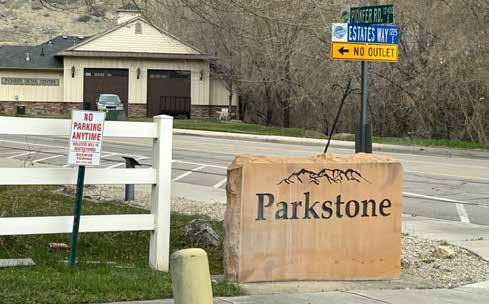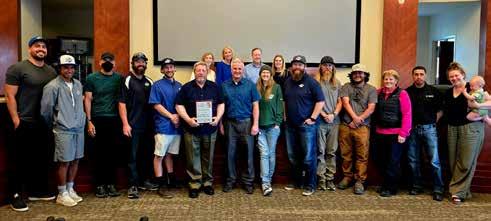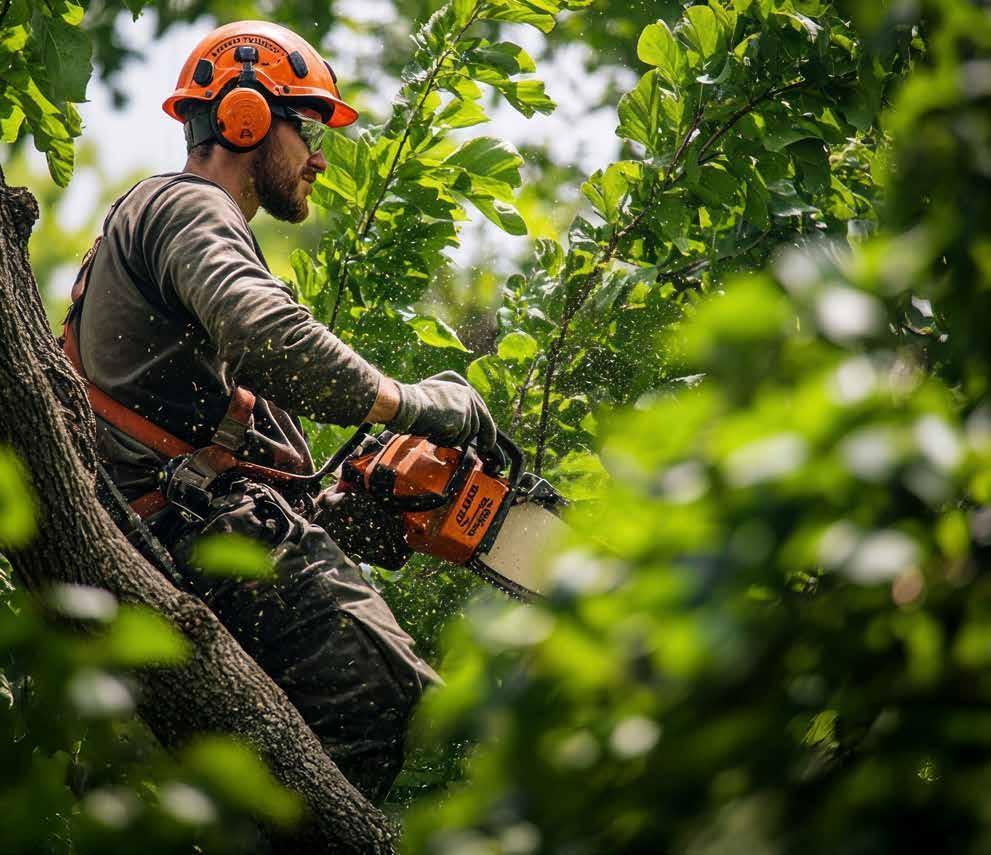




Aly Larson makes the seemingly impossible look easy. The 2023 graduate of Corner Canyon High School and Draper resident has spent years mastering the arts of aerial silks, contortion and foot archery. She performs professionally at public, private and corporate events and appeared last December in a circus in Wyoming. This summer, viewers can watch Larson compete on season 17 of “American Ninja Warrior.”
“I like exposing people to things they’ve never seen before,” she said. “I love performing and the audience interaction. When I perform, I feed off of the audience’s energy. When they go crazy, I feel like ‘they want to see more!’”
Larson has achieved her dream of becoming a professional foot archer and circus performer through years of hard work and dedication. “I started out with dance,” she said. “That lead me to a skill set of strength and flexibility.”
About 10 years ago, she began her study of aerial silks at a local studio. “Silks were my introduction to everything circus,” she said.
In 2018, Larson saw a contestant on “America’s Got Talent” shoot an arrow with her feet and was inspired to try it. She learned to stand on her hands, acquired a toy bow and arrow set and started practicing. It took about five years of training for her to master and perfect the feat to perform it professionally. “I did it

for the talent show at Corner Canyon,” she said, “Those were good memories!”


tunity to compete in “American Ninja Warrior Jr.” “It was a good experience,” she said. “I like to try new things. Recently, I had another opportunity to apply and got accepted. I will be in season 17 which will air this summer.”
The “American Ninja Warrior” competition was taped last fall in Las Vegas. Larson competed in a quarterfinal course with six obstacles. She is keeping mum on the outcome until the program airs.
Larson’s younger sister, Arianna, is also a skilled aerialist on the silks and is a figure skater. Their mother, Maritza Larson, said, “It’s been an exciting journey. It makes my heart very happy to see them happy.”
“Aly has always been very athletic,” she explained. “Both my girls tried every single thing--soccer, ballet, hip hop. We’re always telling them to believe in themselves and don’t be afraid of falling or failing. We always said ‘try it’ when they were little. We encouraged them to be inspiring and encouraging to other kids.”
When she is not performing or training, Larson is completing coursework at the University of Utah to become a physical therapist one day. “Time management helps me to succeed in school and athletics,” she said. “I train almost daily and balance that with my school work.
When she was 13, Larson had the oppor-
Currently, Larson is the only professional foot archer in the state of Utah and performs at events both in and out of state. In 2022, she was in a halftime show for the Utah Jazz. Last fall, she was a mid-show entertainer at the TEDxSaltLakeCity conference. Most recently, she performed in ZirKiss Entertainment’s “Cirque Dream Story,” a holiday-themed circus show in Gillette, Wyoming.




Salt Lake County
801-840-4000
801-799-3000


*If you live in a restricted area, it is illegal to discharge fireworks anytime
*On July 4 & July 24 time of discharge is extended to 12:00 midnight




Draper Arts Council kicks off its summer season with Rodgers & Hammerstein’s “The Sound of Music” at Draper Amphitheater.
By Katherine Weinstein k.weinstein@mycityjournals.com
Thehills surrounding Draper Amphitheater will come alive with the sound of Rodgers & Hammerstein's classic melodies in Draper Arts Council's production of "The Sound of Music." The show, which tells the story of the Austrian Von Trapp family on the eve of World War II, kicks off the Arts Council's summer season, runs from May 30 through June 14.
"It's so beloved, people know the story," director Robin Edwards said. While many are familiar with the iconic 1965 film version starring Julie Andrews and Christopher Plummer, seeing the show live in an outdoor venue is a different experience.
"To be able to be outside and have the hills actually come alive with music is enchanting," Edwards added. "The stage script is also a little different from the movie."
"This is the show you grew up on," actor Heather Burget said. "Everybody knows 'The Sound of Music.' There's just something about this show that makes you feel good."
Burget, who plays Sister Bertha, added, "For me, the theme of the show is the importance of family." She spoke of the character Maria who was studying to become a nun and how she became first a governess then a stepmother to the Von Trapp children. "It's about learning acceptance," Burget said, noting that not all families are defined by blood relationships.
This particular production of "The Sound of Music" is about family in more ways than one. In some instances, family members are performing in the show together.
Burget's daughter, Elizabeth, has taken on the role of Louisa Von Trapp. "I'm kind of just starting out," she said. "I'm enjoying being in the show with my family and being with friends."
Brother and sister Landon and Evelyn Yergensen play Rolf Gruber and Brigitta Von Trapp respectively. Their mother is the choreographer for the production. "Being in a show with my brother is fun," Evelyn said. "It's fun to practice our lines at home."
For a few of the actors, being in the cast is a reunion of sorts as they are once again being directed by Edwards. "I just retired from Olympus High School after 34 years," Edwards

said. "I was teaching theater and directed all the shows." Heather Burget was one of Edwards’ students and played a nun in a production of “The Sound of Music” that she directed.
Tyler Oliphant, who plays Captain Von Trapp, recalled, "Robin directed me in 'Oliver' years ago at Eisenhower Middle School in Taylorsville." Being in a Draper Arts Council production feels like coming home for Oliphant. "Draper Arts Council was the first community theater show I did at age 14," he said.
Serena Mackerell, who has taken on the role of Maria, is also returning to Draper Arts Council. She is enjoying the experience of being in the show. "As a mom, it's fun playing the role of a mom on stage," she said. "I love the scenes with the kids the most. It's so much fun to play with them on stage."
Mackerell explained that the role of Maria is a multifaceted one. "Moms can be other people too," she said. "I love the love story in the show. Doing a Julie Andrews role is a dream come true."
Landon Yergensen and the other young actors who portray the Von Trapp children said that audience members will be in for some surprises in the way that the show is staged.
Jude Hopson, age 12, who plays Kurt Von Trapp, said that in this production, “We don’t always stay on the stage!”
“The audience should go into it knowing that this show will be different,” Summer Taylor said. Taylor, age 9, plays Marta Von Trapp.
“It will be a fun hour and a half journey,” Yergensen

summed up.
Draper Arts Council presents Rodgers & Hammerstein’s “The Sound of Music” May 30, 31, June 2, 6, 7, 9, 13 and 14 at 8 p.m. at Draper Amphitheater. For more information and for the link to purchase tickets online, visit www.draperutah.gov/ events-programs/draper-amphitheater/the-sound-of-music. l
The Draper Journal is a monthly publication distributed directly to residents via the USPS as well as locations throughout Draper.
For information about distribution please email hello@thecityjournals.com or call our offices. Rack locations are also available on our website. The views and opinions expressed in display advertisements do not necessarily reflect or represent the views and opinions held by Loyal Perch Media or the City Journals. This publication may not be reproduced in whole or in part without the express written consent of the owner. © 2019 Loyal Perch Media, Inc.
Scott | bryan.s@thecityjournals.com
Travis Barton | travis.b@thecityjournals.com ADVERTISING EXECUTIVES
Mieka Sawatzki | mieka.s@thecityjournals.com
Lindsay Andreasen | lindsay.a@thecityjournals.com
Jason Corbridge | jason.c@thecityjournals.com
Ryan Casper | ryan.c@thecityjournals.com
Marc Davis | marc.d@thecityjournals.com





























Draper City presents a free concert series Wednesday evenings in June at Draper Historic Park.
By Katherine Weinstein k.weinstein@mycityjournals.com
Draper Historic Park will once again host free concerts on Wednesday evenings for the month of June. Draper City’s Summer Concerts in the Park series kicks off June 4 with the Salt Lake City-based bluegrass band, The Pickpockets. Students from Draper’s Rock U, the cover band Paradox and the B.D. Howes Band are scheduled to perform on the following Wednesdays.
Mandolinist and lead singer of The Pickpockets, Dante Giacobassi, said that the audience at Draper Historic Park “can expect a lively performance in an array of genres. We’ll take you on a journey.”
He described the band’s sound as “new-grass.” “We explore other styles with instruments that are meant for bluegrass,” Giacobassi explained. The Pickpockets perform reggae, funk and rock covers on acoustic instruments along with original songs.
Although based in Salt Lake City, the band has ties to Draper. “We recorded our first album at a recording studio in Suncrest,” he said. “A lot of our songs were written in the mountains, inspired by natural beauty.”
Giacobassi said that some of the band members moved to Utah to enjoy the outdoors. The Pickpockets first formed in 2019. “It started with a few friends. We met others at local bluegrass jams,” he said.
The five-piece band features mandolin, fiddle, upright bass and both acoustic and electric guitar. The Pickpockets are looking forward to playing at Draper Historic Park. “This will be our first, full-band Draper show,” Giacobassi said.
Past Bedtime, Star Soda and Moon Juice will return to Draper Historic Park June 11. All three bands are made up of students taking music lessons at Rock University. Conner Mather, vocalist and guitarist for Star Soda, said that he thinks the audience will notice how far the bands have progressed since they played at the park last summer. “We’ve all become better,” he said, “Our songs are better, more musical in some aspects.”
Rock U has been offering lessons in guitar, drum and voice to young people since 2009. In addition to learning to play instruments, many of the students have formed their own bands and made lasting friendships.
The members of Star Soda range in age from 12 to 14. In addition to performing a variety of covers, the band is writ-


ing new songs as well. Drummer and vocalist Ryder deBry described Star Soda’s evolving sound as “punk, pop-alternative rock.”
“They are all best friends,” Jenny Mather, director of events at Rock U said. “They have a ton of fun outside besides playing together. They all love performing.”
All of the musicians in the band Past Bedtime are currently 12 years old. “We were 10 when it started,” guitarist Merrill Oaks explained. The band had to change their set list since last summer because their voices changed.
Past Bedtime’s unusual name was inspired by their 9 p.m. rehearsal time slot at Rock U. Bass player Jayda Kehl described their country-tinged pop sound, “We play some older songs, some classics but also Benson Boone, Taylor Swift and Shaboozey.”
Moon Juice will also bring their unique brand of jazz-pop fusion back to the park. The band, comprised of students from Corner Canyon High School, have developed a large fan base over the past few years. Their upcoming gig at Draper Days next month will be one of the last opportunities for fans to catch Moon Juice before the members embark on their post-high school plans.
The band Paradox will perform at Draper Historic Park June 18. Vocalist and keyboard player, Bryan Chapman, described the group as “a cover band.” “We play a mix of classic and soft rock, all the hits,” he said. “Light music is fun, it’s worth celebrating.”
Paradox performs songs by Pablo Cruise, Christopher Cross, the Eagles, Doobie Brothers and Journey and many others. The band gives these classic covers a unique twist with mul-

tilayered vocals and a guitar duo.
“For the lead solos, they hand it back and forth,” he said, describing the way in which guitarists Ben Howard and Cory Jensen turn guitar solos into duets. “They love to play together,” he added.
Paradox also has a community connection as both Howard and drummer Ken Law reside in Draper. The band rehearses at Law’s home. Paradox formed in 1978 and three of the current members were in the original band. “We have a revolving set of people who have played with us over the years,” Chapman explained. “It’s an extended family of Paradox players.”
Currently, the band is made up of three vocalists, two guitarists, a drummer and a bass player. Chapman said that friendship and love for the music has kept the band together for so many years. “It’s just fun to get together with these guys and play,” he said.
The members of the B.D. Howes Band have been together for over 20 years. Singer/songwriter B.D. Howes described the band’s sound as “eclectic rock.” They have played a mixture of covers and original songs at gigs along the Wasatch Front for years in addition to producing their own albums.
The band’s set list alternates cover tunes with originals. “It’s 50/50,” Howes said. They cover pieces by artists both old and new, crossing genres of rock, pop, country and more. Audiences may hear songs by bands ranging from classic rock icons Led Zeppelin, Paul McCartney, Fleetwood Mac and U2 to current artists such as Adele and Lady Gaga.
Howes explained that these artists and groups have served as inspiration to the band over the years. “When you’re watching someone and you just fall in love with their style, you can’t help but get inspired,” he said.
The B.D. Howes Band, which is based in Salt Lake City, consists of four members on vocals, guitar, bass and drums. Howes, who sings and plays acoustic guitar, is the front man. Douglas Hunter plays lead guitar. He recalled that the band performed at Draper Historic Park a couple of years ago. “We had a great time, it really is a great audience,” Hunter said. “And it’s a fun place to play, right in the middle of your city.”
The Draper Summer Concerts in the Park begin Wednesdays in June at 7 p.m. at Draper Historic Park, 12625 S. 900 East. Audience members are invited to bring blankets, lawn chairs, snacks and beverages although alcohol and glass bottles are prohibited. The concert series is organized and sponsored by Draper City. l

By Julie Slama j.slama@mycityjournals.com
Afewyears ago, Barbara Ingebrigsten’s adult daughter, Heidi, was hiking near the mouth of Little Cottonwood Canyon when she spotted three chicks abandoned in a plastic container near the trailhead.
Heidi brought them to her Sandy home, and after struggling to find anyone willing to raise them, she built a chicken coop. Together with her mother, they began raising the hens.
“We didn’t set out to do this, but we’ve loved the fresh eggs which have more omega-3,” Ingebrigsten said. “It’s been quite a process to learn, but the hens love people. I open the back door, and they know I’m coming; they can recognize 100 different faces. We can hold them, one hops up and down for treats and they’re funnier than heck. Each has a different personality.”
Ingebrigsten isn’t alone.
There are more than 85 million backyard chickens in the United States, with 17 million households owning an average of five chickens, according to the National Institute of Health. The organization reports this trend grew during the COVID-19 pandemic.
IFA-Draper Assistant Manager Elizabeth Maycock isn’t surprised by the rise in chicken ownership.
“More people own chickens than you think; in my circle alone, four households have chickens,” she said about her Magna neighborhood. “This morning, we got 160 chicks with our weekly delivery at 11 o’clock and they were gone within 40 minutes. It reminds us of COVID, when we were selling out within an hour. Everybody wanted the chicks to kind of start their homesteads then and we’re seeing the same kind of a demand.”
Maycock believes the current bird flu, which has reduced commercial egg production, plays a big role in the trend.
“Egg prices have skyrocketed and there’s
from front page
I’ve always been drawn to a career in athletics and find physical therapy very interesting.”
Larson also loves music and has taken up deejaying, but “circus work” is her passion. She wants to build her career and perform as long as she can.
“I really like how I can have fun while doing something that’s athletic,” she said. “I love when I have little girls come up to me after a performance. I love being someone’s inspiration.”
“American Ninja Warrior” season 17 will premiere on NBC in June 2025. l

a push where people want to go back to homesteading and providing their own food. That movement has slowly risen over the last five years, but the panic surrounding the egg prices has really been an issue over the last three or four weeks and I’ve seen it getting worse. I’ve seen it creeping into Utah, up in Cache Valley. It’s been hitting hard there,” she said.
Maycock, like Ingebrigsten, owns chickens herself. She currently has 14 and was purchasing five chicks to add to her flock.
“We get enough eggs for the five of us living at home and then, we give some to my son and his family every once in a while, because the four he’s allowed to have don’t provide enough for his small family,” she said.
In the winter, her hens average four eggs per day, but in the summer, it increases to a dozen.
“I’m not selling any right now, but I know people are selling them around $8 per dozen right now,” she said. “The stores are a little cheaper, but these are fresh while commercial eggs are sometimes three to four months old when you get them. The fresh eggs are much healthier. They have better vitamins and omegas. You can choose the feed your hen eats that then produces your egg, whether it be the organic, soy free, those types of things. Then you know what you’re eating. That’s another trend; people are trying to understand what they’re eating. They’re raising their own animals because they want their children to know where their food comes from.”

In early March, a dozen commercial eggs at a South Jordan Wal-Mart were selling for $6.12, while the national average was $8.53, according to the USDA in late February.
Before grabbing those cute chicks, Maycock recommends researching raising chickens.
“Read up on them before you get them. I always recommend that with any animal, so you know everything about them before you invest your time and your money. Basically, if you can take care of a dog, you can take care of a chicken; they need food, water and shelter,” she said.
Maycock said while raising chicks is enjoyable and they bond with their owners, another option is to adopt other people’s flocks. Many people sell or give away their chickens when moving, allowing owners to start with adult laying hens rather than waiting six months for chicks to mature. She suggests starting with at least three hens, which will lay eggs for three to four years.
“They’re a flock animal, so they need each other to be happy. A lot of city ordinances won’t allow you to have more than six and they won’t allow you to have a rooster either,” she said.
Cost is another factor to consider, as it is with any pet. While her family built their hen coop, prebuilt three-hen houses cost about $300.
“It’s an investment initially since you won’t see eggs for the first six months. They need roughly one square foot per chicken. I give them a little bit more because I let them free range a little bit. Mine sleep in the coop, they lay their eggs in there. The rest of the time they’re out foraging. They’re out mingling with each other, even in the winter,” she said.
While many people don’t have enough space to grow their own food, Maycock estimates one-half to one cup of feed per chicken per day. For three chickens, expect to buy a 50-pound bag for $18 every two months. Her feeder, a treadle feeder which chickens step on to open the lid and access food, costs about $100. She said it helps keep rodents and other birds away.
Maycock mentioned chickens can pro-
duce a lot of manure, but it’s compostable and great for gardening.
Another consideration is having someone care for the chickens while on vacation.
“I find one of the drawbacks when people come in is that they still want to take their vacations; many will get their neighbor kids to come on over and they let them keep the eggs for the days they watch them,” she said.
Maycock believes the benefits of her children learning self-sustainability and responsibility outweigh any of her other initial concerns.
“They understand more about their food and what goes in to raising them,” she said, adding in the past they’ve had goats, rabbits and other birds for both food and to make yarn. Her family got their chickens when her children were in elementary school. After a year of her teaching them, her children took over their care, which includes carrying buckets of water, carrying feed to the coop, gathering eggs and cleaning the coop.
“That’s probably the worst part,” said her daughter, Anna. “Thankfully, we don’t clean it that often. I have a Wyandotte (chicken) and she follows me around. I can call her and she comes running to me. I love her friendliness.”
She and her siblings have named their chickens after founding fathers, states and more. She is considering naming a yellow chick after her favorite flower, a sunflower, because of its color.
“The chicks don’t all have to be the same; you can mix breeds,” Maycock said. “You can go about two weeks in between shipments of chicks, and they’ll still integrate. They all have their own personalities. Some will be more dominant in the pecking order, and some will be more docile. It’s fun to know each one.”
After enjoying raising their first three hens so much Ingebrigsten and her daughter added three more the following year, which Ingebrigsten’s grandchildren named. They even put party hats on their chickens to celebrate family birthdays.
“I walk outside and say, ‘hi girls,’ and they come running over,” she said. “There’s nothing like raising them and the eggs are delicious.” l


Rendering for the Town Center Station Area Plan (SAP). In 2022, the state mandated master plans for areas around all TRAX and FrontRunner stations throughout the state. SAPs are due this December or cities face consequences. Draper’s Planning and Development department has been working on the SAPs for several years with special attention given to the Town Center, near City Hall. (Courtesy Draper City)

Since 2022, city officials have been working to develop Station Area Plans for Draper’s four transit stations, a huge task with a Dec. 31 deadline.
By Mimi Darley Dutton m.dutton@mycityjournals.com
In2022, the Utah State Legislature passed HB 462 mandating master-planned Station Area Plans (SAP) around transit stations including TRAX and FrontRunner. If cities don’t comply, consequences from the state include losing transportation funding for road maintenance and fines of $500/day until a city complies. The state’s deadline for all SAPs is Dec. 31.
“We are required under state law to fully comply, so that is the city’s goal and the city’s plan,” said Jennifer Jastremsky, Draper’s community development director.
Jastremsky has been in the city’s Planning and Development department for a dozen years. Her team has been hard at work coming up with plans since HB 462 passed. “We first start a stakeholder committee with area residents and business owners, people within the boundary of the SAP, to get a good representation of their different interests and concerns, what they want to see protected, or what kind of development they want to see. Staff works with consultants to come up with different concepts. We take that back to the stakeholder committee, we hold an open house for the general public for feedback, then it’s fine-tuning that concept. The City Council has representatives working with us throughout that process and we keep the council up to date on feedback we’re hearing. Ultimately, after the open houses and feedback, we come up with a general concept that will be presented to the City Council. We make more modifications, then it goes to the Planning Commission and then the City Council for review and adoption,” she said.
But that’s not all. “There’s an additional process after the city adopts the general plan. The Wasatch Front Regional Council (WFRC) has to certify the plan. They’re a regional planning organization that looks at transportation and land use. They work with cities to coordinate master planning on a regional level,” Jastremsky said.
Four objectives must be met in each SAP:
1) Increase the availability of affordable housing
2) Promote sustainable environmental conditions including utility usage, water efficiency and waterwise landscaping, alternative energy and consideration of energy impact
3) Enhance access to opportunities including the opportunity to own an affordable home, access to transit to get to work more efficiently, and access to parks or schools
4) Increase transportation choices and connections
Draper has four transit stations for which SAPs are required:
1) Town Center-TRAX station northeast of City Hall
2) Kimball’s Lane-TRAX station at 11800 South and 700 East
3) Crescent View-TRAX station at 11400 South and 500 East. Technically in Sandy, but SAPs must encompass the area within a half-mile radius of each station. Sandy City and Draper City are working collaboratively on this SAP.
4) Draper FrontRunner on the west side
The city tackled the Town Center SAP first and adopted it at the March 4 council meeting.
“We started with the Town Center realizing… it gives the city an opportunity to decide what we want that to look and feel like. We’ve been working on that the last several years,” Jastremsky said.
Components of the Town Center SAP in-
clude additional housing units, a community/ arts center adjacent to City Hall on city-owned property, a plaza, a courtyard and trail connections from City Hall to Draper Park. The UTA property can also be developed, but that’s up to UTA to determine when and how. The SAP calls for up to five-story multi-family housing and mixed use along 12300 South by the UTA parking lot, with business and retail on the ground floor and residential above.
Several residents from the Parkstone neighborhood came to the March council meeting to voice their concerns. Parkstone consists of approximately 40 homes nestled between the TRAX station on Pioneer Road and the UTA owned property and parking lot located off 12300 South. “I love the idea of redevelopment and creating a walkable area and making a gathering spot, but the issue I’m struggling with is transportation. I don’t see anything for that other than light rail. When you drive around during rush hour, some of these areas are at failure right now, including the roundabout. How is the transportation in this narrow area going to be addressed? I can’t imagine bringing in that density without major changes to the roads,” Paul Skeen said.
“The data I can find online shows this is the lowest ridership of any TRAX station in the entire system…and yet we are affected 100% as though we have a lot of ridership. It’s the end of the line, and I don’t see in the future that will be extended. It’s not preserving this community, it’s changing it,” Steve Taylor said.
Mayor Troy Walker responded to residents’ concerns and gave a history of the SAP mandate, reiterating what he’s long said about the legislature putting the blame for the housing crisis on cities. “We all know that is not 100% the truth,” Walker said. “We have to show a plan that’s dense enough to pass. We have to do it. The thing you can take comfort in is it’s just a plan. Just because we show big buildings
doesn’t mean it will get built. If our council could plan it, it would not be this plan. We are not unique to this requirement, everybody that has a transit stop has to do them. This is the political reality we are in. I want you to know this is not your city council doing it to you because we want to. It’s because we have to,” he said.
Following Walker’s statements, every member of the council spoke. “This has been hard on city staff,” Marsha Vawdrey said.
“This was forced upon us. We’ve worked hard to come up with a place for citizens to gather. We can look for the good parts in this plan and we’ll continue to work on this. Traffic is a big concern I have as well,” Bryn Johnson said.
Mike Green thanked the people who came to the council meeting to give their input. “We love our community and we love when you join us in meetings,” he said.
Fred Lowry noted this doesn’t necessarily mean there will be five-story buildings in the end. Lowry said the council is aware of the traffic, but they have to follow what the state is mandating.
“This threat to local control is very real. The city is a subsidiary of the state and we only have so much power comparatively, so we do our best where we can. We bought the land adjacent to City Hall so we would have control. We’re doing everything possible to keep the Draper we all believe in,” Tasha Lowery said.
With regard to Parkstone, “The SAP calls for buildings next to them not to be taller than three stories,” Jastremsky said.
An open house for the three remaining SAPs will be held June 5 at City Hall. More information can be found on the city’s website and residents can call the Planning Department if they have questions or want to provide feedback. “We’re looking at doing a survey via social media and on the website as well,” Jastremsky said. “That’s forthcoming.” l

By Mimi Darley Dutton m.dutton@mycityjournals.com
“This is everybody that makes the engine go,” said Rhett Ogden, Director of Draper’s Parks and Recreation, as he posed with his team for a picture. They were recognized as Department of the Year by the Utah Recreation and Parks Association (URPA) at
the April 22 Draper City Council meeting. The association looks at three pillars; focus on health and wellness, stewardship and access for all. “Your department is doing great things,” said URPA’s LeeAnn Powell as she presented the award. “We have a lot of parks in our community. Good work. Your department is most definitely deserving of the award,” said Mayor Troy Walker. (Courtesy Draper City) l

By Julie Slama j.slama@mcityjournals.com
In a state finals against Weber High, Corner Canyon High’s coed unified basketball team came up short in a hard-fought game. The Chargers had secured the opportunity to play in the March 28 championship in their division at the Delta Center after advancing from the regional Canyons-Jordan-Murray school districts’ tournament. Unified basketball embraces students with and without intellectual disabilities to play side by side. The program, supported by both Special Olympics Utah and the Utah High School Activities Association, now boasts more than 200 high school coed unified basketball teams across the state. l

Loveland Living Planet Aquarium recently welcomed a new female North American river otter to the Discover Utah habitat.
By Katherine Weinstein k.weinstein@mycityjournals.com
TheNorth American river otter pup in this photograph is now an energetic 1 year old getting used to her new home in the Discover Utah habitat at Loveland Living Planet Aquarium. The female otter was transferred to the Aquarium last April 29 from Woodland Park Zoo in Seattle, Washington as part of a collaboration among American Zoo & Aquarium (AZA) member organizations to care for and educate the public about the species.
The otter may now be seen by guests as she explores her environment and gets acclimated to her new living space. “We are
thrilled to welcome this playful otter pup to our Aquarium family,” said Layne Pitcher, vice president of Marketing and Operations. “Not only will our visitors enjoy watching her energetic behavior, but they’ll also gain a deeper appreciation for the rivers and wetlands she represents.”
The otter habitat at the Aquarium is already the home of Oscar who shared the space for years with his brothers, Otis and Oliver. According to the Aquarium’s Instagram, Oscar’s brothers passed away from age-related health issues last year. The husbandry team is introducing the new otter to Oscar gradually and with great care to ensure a positive experience for both animals.
Loveland Living Planet Aquarium offers its guests unique opportunities to learn about aquatic ecosystems and the amazing animals that depend on them. For more information visit livingplanetaquarium.org. (Photo courtesy of Loveland Living Planet Aquarium) l



Tree Utah and Draper City put out a call for volunteers to plant 20 zelkova, honey locust and elm trees at Rotary Park for Arbor Day.
By Mimi Darley Dutton m.dutton@mycityjournals.com
Rotary Park on the road to Riverton is the recipient of 20 new trees planted April 26 to commemorate Arbor Day. Nonprofit Tree Utah partnered with Draper City for the event. They put out a call for volunteers to plant the trees near the park’s new disc golf course and walking paths. Tree Utah also provided matching funds for the city to purchase the trees.
Tree Utah staff stressed the importance of selecting appropriate trees that will successfully grow in this area. “We’re planting zelkova, honey locust and elms, tough trees that do well along the river corridor, even with the wind. We want to plant them so they’re here well beyond us,” said Director of Tree Utah Amy May. Arborist Erik Stratton demonstrated the correct planting procedure for the volunteers.
Stratton offered the following tips to successfully plant a tree:
To start, consult with an arborist at a nursery to select an appropriate tree.
Don’t plant right next to a sidewalk or walking path, give the tree space to grow.
Dig a hole big enough to accommodate the tree.
Scratch the sides of the root ball to loosen the roots before putting it in the hole.
Make sure the tree is straight in the hole before surrounding it with soil.
Don’t cover the root crown, only put soil around the sides of the root ball.
Don’t apply fertilizer, trees are wellversed in getting into the native soil.
Top with mulch and water the tree for a successful start.
Jim Colby and his 9-year-old son Emmett volunteered on behalf of Jim’s employer, Jordan Credit Union. “I’m a big fan of planting trees. They’re so good for the environment, and I’m always looking for a fun experience for my little guy,” Jim Colby said.
Chiquita Jones and Desiree Mealing brought their young children to help. The kids weren’t afraid to get their hands dirty, helping dig the hole and scratching the root ball to loosen it up before surrounding it with soil. “This is our fifth time volunteering. Whenever we’re available, we like to come by and lend a helping hand,” Mealing said.
Gary and Becky Rogers live across

from the park and walked over to participate. “We’re happy to be supporting our neighborhood,” said Gary Rogers, who walks the park’s trails several times each week. The Rogers have lived there for 20 years. Gary Rogers said the new disc golf course has been a fun addition to the park, bringing pros and amateurs alike. Becky Rogers said she’s pleased the disc golf course has brought family-friendly activity to Rotary Park.
David Cloward is chair of Draper’s Tree Committee. “The goal of the Tree Committee is trees that benefit generations. That’s not an easy goal. We have to pick the right trees and plant them in the right way,” he said.
According to Draper Parks and Recreation Director Rhett Ogden, the city ran 600 feet of irrigation to support the new trees. The city also caged the new trees to protect them from animals until they get established. “These trees will be a great addition. We’re going to make this a beautiful
disc golf course,” Ogden said.
Councilmember Bryn Heather Johnson spoke to the volunteers and told a story from her childhood in Virginia when she helped plant trees along the walking path to her school. Through the years, Johnson said, she has watched the growth of the tree she planted and she encouraged the kids in attendance to do the same. “Watch it grow and think about the effort you put into it today,” she said. That’s something the Mealing family has already done after volunteering with Tree Utah in the past. “Being able to come back and find the tree we planted is really neat,” Mealing said.
Draper City hosts an Arbor Day ceremony annually, one of the requirements for maintaining the city’s Tree City USA status. This year’s event took place on a sunny Saturday with rain predicted the next day, likely giving the trees an even better start at settling into the soil and their new home. l






Three new members for the TRSSD Administrative Control Board bring fresh perspectives and representation to keep things running in Draper’s unique mountain community.
By Mimi Darley Dutton m.dutton@mycityjournals.com
Draper City Council interviewed and appointed three new members to the Traverse Ridge Special Services District (TRSSD) Administrative Control Board. The council selected Mark Vincent and Paul Kearsley to serve four-year terms and James Hether to serve a two-year term.
“We really appreciate these gentlemen stepping up and getting involved in our community,” Mayor Troy Walker said.
The TRSSD was established in 1999. Its residents pay a special tax in addition to regular city taxes to cover expenses unique to their mountain community. Those extra expenses include special streetlights, extra snow equipment and plowing, and road maintenance and repair. The TRSSD’s biggest expense is snow plowing and removal.
The TRSSD Administrative Control Board, comprised of volunteers who are district residents, was established in 2014. The board works with the city and is tasked with managing the budget for the required special services. The board consists of five members plus a treasurer. In 2022, they held a truth in taxation hearing and increased the tax rate to recover from debt incurred by a previous board.
Vincent is a retired businessman who moved to Draper five years ago. He told the council he has both big and small business operating experience. Vincent said he has attended all TRSSD meetings and was encouraged to get involved by current board chairperson Daryl Acumen. “I survived ‘Snowmageddon’ a few years ago and am familiar with the unique aspects of the community. I’d like to volunteer and be a part of this,” he said in his interview. Asked by councilmember Tasha Lowery if he has any specific concerns about the TRSSD, Vincent said he thinks communication could be improved, and he hopes for more regular meetings to be scheduled, perhaps quarterly.
Kearsley has lived in SunCrest for more than four years. He previously lived in Millcreek for three decades and recently retired from his role as Director of IT operations for the State of Utah. He currently serves on SunCrest’s community council/HOA. “It’s important to be involved in your community,” Kearsley told the council in his interview. Lowery asked Kearsley about communication and transparency for the board. He said he supports being upfront about costs and providing information as it relates to cost could be done using different tools to make it readily available and easily searchable for residents. Kearsley also supports a regular, ongoing meeting schedule for the board with minutes taken and published.

businessman Mark


Asked in his interview if he’s comfortable using social media as a communication tool for the board, Kearsley said it sometimes invites rants where people aren’t civil in the discourse, so he wouldn’t want to rely solely on social media.
Hether is retired from a 35-year career as a chiropractor. He moved to Draper from Florida nine years ago. While in Florida, he was a professor at two different colleges while also working full time. He worked with the Port Orange, Florida mayor to develop a large chiropractic college. Hether said he appreciates the snow removal in SunCrest but would like to see the street lights fixed, especially since one near his home has been out for a year. Lowery described the TRSSD streetlights as “an ongoing conundrum.”
Acumen joined the TRSSD Administrative Control Board in 2020 and has served as chair since 2021. He said things have been “smooth as glass,” for the board since the 2022 tax rate increase, including a relationship with city officials that he described as “collaborative and built on trust and mutual respect.” Acumen had high praise for the board’s treasurer, Drew Joosten. “He is brilliant and tenacious. I take the political and legal end of things, and he takes the financial,” Acumen said.
“The 2023 snow season was a nightmare. We had budgeted for one big snow year every three or four years. The next year was a little heavy but not terrible. Since then, the snows haven’t been that bad which is bad for Utah but good for us. And the city has been diligent about costs,” Acumen said.
Because things were running smoothly in the last several years and it was also hard to get all the members of the board together, Acumen said they haven’t had quarterly meetings like they used to. With the new board members, he wants to get back to regular meetings. Hether is his neighbor, and Acumen said the next big issue for the board is maintaining and repairing SunCrest’s unique lights, so he plans to put Hether in charge of that. “It’s an important issue and he’s passionate about it,” he said. Acumen has already communicated with the city’s Pub-
lic Works department to ask what assistance is available with the special lights and he said the city is willing to fix and update them at a reasonable cost. “I think we’re going to vote and give the city permission to take over light maintenance. We have the budget and we’re going to make an investment to partner with the city and get it done,” Acumen said.
In addition to Hether, Acumen is excited about the perspective Vincent and Kearsley will
bring to the board because they live in a newer development in the TRSSD, one that has not had representation on the board before. That development has wider streets, doesn’t have the special street lights, and isn’t part of the SunCrest HOA.
“They have unique challenges, and I think that’s important for representation,” Acumen said. “Having those guys on the board is going to be really nice.” l
SINGLE WASH $24
UNLIMITED WASH CLUB: $40/MONTH
SINGLE WASH $12
UNLIMITED WASH CLUB: $22.50/MONTH
SINGLE WASH $20
UNLIMITED WASH CLUB: $35/MONTH




Teen donates portion of college fund to help local elementary students eat lunch debt-free.
By Julie Slama j.slama@mycityjournals.com
Starting July 1, about 40,000 students in Utah will receive free school meals, thanks to House Bill 100, the Food Security Amendments. This legislation eliminates reduced-price lunches, making them fully free for students who previously qualified for the reduced rate.
Sponsored by state Rep. Tyler Clancy, the new legislation aims to address food insecurity and promote share tables to reduce food waste. It guarantees free school lunches for eligible students — from kindergarten through 12th grade — at any school participating in the National School Lunch Program.
Darrell “DJ” Bracken, a West Jordan parent and community advocate, believes the new law also will help tackle Utah’s growing school lunch debt, which reached $2.8 million last year.
“I was just down at the capitol yesterday when Gov. (Spencer) Cox signed the bill,” he said. “I was a part of the coalition along with The Policy Project and Utahns Against Hunger; we advocated for it for about eight months. I think it was very hard for legislators to directly reject the idea of feeding kids at school. I think it’s something everybody can get behind.”
Bracken was shocked when he first learned the extent of lunch debt in his local school district.
“I thought that was impossible. I called Jordan School District and they confirmed to me not only is that number true, but there’s $88,000 in debt in elementary schools alone within my district. I was just completely blown away,” he said.
Motivated to act, Bracken began by paying off Bluffdale Elementary’s $835 lunch debt himself. That experience led him to start the Utah Lunch Debt Relief Foundation to ensure no child in Utah schools goes hungry or accumulates meal debt.
“I thought other people would be just as upset as I am that this exists — and I was right,” Bracken said.
His foundation is designed as a temporary solution to a systemic problem.
“I didn’t want to fill a role I personally felt the government should already be filling so it’s in our charter we will exist until we have gone one full calendar year without any school lunch debt in the state of Utah. This bill is a great solution. It does many great things, taking the group of kids who are getting reduced lunch into getting free lunch. But there’s still going to be lunch debt. I view this as kind of a steppingstone toward healthy
school meals for all; that has been passed in a lot of other states. I would like to see that passed in Utah,” he said.
Bracken’s efforts gained momentum after a single Facebook post in July 2024.
“That got a lot more response than I expected, and we’ve been paying off schools ever since,” he said.
By mid-April, UTLDR had raised more than $51,000. The foundation has cleared meal debt at several schools: Bluffdale, Oakcrest and Aspen elementaries in Jordan School District; South Kearns Elementary in Granite School District; Liberty Elementary in Murray School District; Butler, Quail Hollow and Sandy elementaries in Canyons School District; and more schools in Davis, Provo, Carbon and Duchesne school districts.
Bracken’s goal is to pay off meal debt at an elementary school in every district statewide.
“We’re well on our way to doing that,” he said. “It’s mostly individual people finding our website and deciding to donate on their own, but we have had a couple partnerships with businesses. It’s really been an amazing thing to see how many people care about this.”
Some donations come from individuals moved by the cause. One is 17-year-old David “Van” Hafner, who contributed $2,500 toward paying Butler Elementary’s $6,050 lunch debt. Lunches in Canyons School District cost $3.
“I had my own college saving fund and I dipped into that, plus savings from my many summer jobs and money I saved from the stock market,” he said. “I had a lot of money saved up different ways, so I pulled it all together. I like the idea of doing philanthropy, and I thought this was perfect.”
The Alta High junior also volunteers at a West Valley City daycare and plans to join a humanitarian trip this summer. He was honored with the Smith’s Zero Hunger Award and intends to continue helping schools.
“It’s important I’m doing this because kids at a young age need to learn to help the community, to help other people. I wanted to make an example of that by giving my money to kids who can’t pay for their own lunch. The main concern is kids eat, especially a growing little kid,” said the student who hopes to become a doctor.
His generosity left a lasting impression at the Cottonwood Heights elementary.
“The people at the front desk were very thankful and the kids were excited. They said, ‘That’s a lot of money,’ and ‘That’s really cool.’ It made me feel great. That’s why I want to donate to another elementary school,” Hafner said. “Between this and the West Valley City daycare, it feels like I’m making a difference.”
Butler Principal Tracy Stacy said she was both surprised and grateful for the donation.

Another community member contributed; she encouraged her gym members to get involved and raised money to help pay off Sandy Elementary’s lunch debt, Bracken said.
At Aspen Elementary in South Jordan, Bracken’s foundation donated $2,100. However, debt stemming from $2 per lunch continues to be a recurring issue, said Principal Suzie Williams.
“We’re grateful for the donation, absolutely, and we’ve used it, but we don’t want it to be a crutch for people either,” Williams said. “We want to help them navigate how to pay or qualify for lunches. When he came, he tried to reach out to a bunch of families and educate them about filling out forms for free and reduced lunch and that helps, too.”
She noted despite the efforts, debt remains a challenge.
“His donation helped, but we got back up to $3,000 deficit (in late March). When you hit $50 in Jordan School District, then it goes to collections. We called several people today and told them that — and it’s awful. Our lunch debt is down now at $1,700 (as of late April); there always is a debt,” Williams said.
At Liberty Elementary where school lunch is $1.90, Principal Shana Mondragon echoed similar concerns.
“We are consistently in the negative. We’re constantly reaching out to families asking, ‘Do you need help? Have you applied for free and reduced lunch? Do you qualify?’” she said. “I think families are struggling. The responses I get when I call range everywhere from ‘I totally forgot to pay’ to they don’t know how to fill out the form, or didn’t know there was a form. There’s also everybody ate lunch for free during COVID so the assumption is it’s still going. I do appreciate in Murray, regardless of what their balance is, students have the option to get a full lunch every day. It doesn’t fix the budget side of it, but
the kids will always get a full meal. Murray District’s top concern is that the kids eat. We’ll figure everything else out later, but we need to make sure the kids have food. “
Mondragon praised Bracken’s dedication to helping families and spreading awareness.
“DJ was helping to educate the families, making sure they had access to the information. He really wants to fix the problem. It isn’t a new problem. If anything, it just keeps getting worse. So, making sure there’s funds, making sure there’s accessibility to the resources and knowing what to do is important,” she said, adding Bracken was honored for his $560 donation to pay off the lunch debt as well as his contribution toward fixing the issue during a “hidden hero” school assembly. “The banner for his foundation is on our website and on our fence to recognize what he did.”
Bracken said the foundation continues to expand its outreach.
“There are many great causes in the world. I have a 7-year-old daughter so this was easy for me to picture a world where there’s some kid out there who’s worried about getting school lunch, and how are you supposed to learn if you’re worried about being in debt instead of focusing on things like fractions?” Bracken said. “It struck me as a failure of the system. These are kids who are accruing debt for the right to eat at a place they have to be —– and we all want them to learn. We all want them to succeed. I was just completely aghast this could even exist, and it turns out most people are too. I couldn’t stand for it. Someone had to do something; I’m glad it’s made an impact so far. Hopefully we can make the full impact and make it so no kid ever has to worry about where they’re getting their lunch again.”
To support or learn more about the Utah Lunch Debt Relief Foundation, visit utldr.org. l
Mother of six and grandmother of two, is driven by passion and desire to help others in their fitness goals.
By Julie Slama j.slama@mycityjournals.com
ADraper resident finished the Boston Marathon for the second time — and already has qualified for her third.
Just two days prior to the 129th running of the Boston Marathon, 47-year-old Karin Nielson Nelson also ran the Newport Rhode Races marathon in Newport, Rhode Island, her 31st state toward her goal of running a marathon in all 50 states before she turns 50. She has run most of those marathons in the past two years.
“One of my favorite things to do on a Saturday is to go for a long run, and that’s how I treat many of them,” Nelson said. “I get a long run in a new state, and I see a beautiful place. I get to know people on the course, and I just have fun. I meet people who I can help pace them to their goals and help them, because I don’t need to win; I don’t care. I do run some fast, but for the most part, I’m running for the enjoyment. Either way, I get a medal.”
The 1996 Hillcrest High alumna displays those medals on a plaque gifted to her by her husband.
“I color in each state on my little chalkboard, and it’s satisfying,” she said, adding she generally only kept her race bibs from Boston.
Nelson’s quest to run all 50 states began recently.
“I did sprints in high school. My body is built for short distance. I have the stronger quads, I have the power muscles,” said the Husky alumna, who graduated with a 3.9 grade-point average and participated in cheer, dance company and several clubs. “I was ‘Little Miss High School.’”
At BYU, Nelson stayed active with dance and occasional running while earning her degree. Inspired by Oprah Winfrey’s marathon story, she signed up for her first race 20 years ago.
“Between my number two and number three child, I read Oprah Winfrey had run a marathon, and I thought if Oprah can do it, so can I,” she said.
Nelson followed a marathon training program online.
“I was so excited when I first hit six miles on the treadmill. I was so proud of myself. I built my mileage up and, on the weekends, I met up with a friend from high school, and we would just run down the canyons, trying to get our quads strong for the race,” she said. “When I ran Top of Utah, everything fell apart. I had stomach issues, and I lost a toenail. I hated every second of it. I quit running for 15 years; I was never
going to do a marathon again.”
Moves to California and then Georgia reignited her training. Nelson entered a local half marathon and placed first in her age group.
“I pushed it and I got first in my age division, and I was like, ‘I’m faster than I thought,’” she said, but also knew “I never was going to make Chicago or New York or any of the bigger races; I wasn’t close. But this one felt good.”
Nelson joined a group of early-morning runners.
“It depended on how long we’d run as to what time we’d start,” she said, adding her sixth child was just 18 months old so often, she’d nap with her after running up to 20 miles before getting her other kids off to school. “Those runners were fast. I ran with them; I didn’t think anything of it. We chatted while running and had a party.”
In November 2019, Nelson attempted to qualify for Boston at the Chickamauga Battlefield Marathon in Georgia.
“I wanted to qualify for Boston. I was shooting for around a 3:35 pace, but I didn’t know how to fuel. I was a rookie. By mile 17, my batteries just ran out. I was completely depleted. My time was a 3:40, just off the qualifying time,” she said.
Still determined to qualify for Boston, Nelson and another runner in the group “trained our butts off. I was in the best running shape of my life, going as fast as I’ve ever run.”
Then, COVID-19 canceled the race. She attempted Boston qualification again at the Surf City Marathon in California, but illness and high heat thwarted her race pace.
An unexpected entry into the St. George Marathon followed, where Nelson clocked a sub-four-hour finish.
“It was respectable, but it wasn’t at all my goal pace,” she said.
Nelson’s next attempt, at the Mt. Charleston Marathon in Las Vegas, was emotionally charged.
“The day before the race, my mom called to say my dad was in the hospital,” she remembered. “I ran that race, thinking about my dad the whole time and dedicated to him. He passed away a couple days later, but I made it back to see him.”
Nelson finished in 3:38—fast enough to qualify for Boston.
That’s about when she learned about the 50-state challenge.
“I was like, ‘That’s cute. I’ll think about it.’ When I was talking to one of my best friends, she said, ‘You’re 45 you should do all 50 before you turn 50,’” she said.
Nelson turned to a 50-state marathon club on Facebook and was encouraged by others to “totally go for it.”
At that time, she had run marathons in five states, including New York City, and
had planned to run Grandma’s Marathon in Duluth, Minnesota. Still undecided, Nelson ran one in North Carolina on Mother’s Day, her third in three months.
“That’s when I became fully committed to 50 by 50,” she said. “I know it’s crazy, but I’ve enjoyed it. I meet the coolest people; I help pace them to their goals and get to know them.”
Nelson finds it rewarding to pace others.
“I’d rather be a friend to somebody and enjoy the race. I get so much more out of that because who cares if you win all the time? That’s very self-serving. It doesn’t do anything for anybody, plus, it’s not good for my body,” she said.
To help fund races, Nelson has coached fitness classes both in Georgia and Utah.
Through dozens of marathons, she’s honed her strategy.
“Last May, I ran Conway, North Carolina, after running others, and I got a 3:34 so I beat my PR by four minutes. I’ve discovered, I do a lot better if I keep training than take a month off. I bounce from one to the next just giving my legs a little rest the week after a race and the week before a race,” she said.
Despite the demanding schedule, Nelson has remained strong, even placing in the top three at the Marine Corps Marathon in amongst competing in other marathons in several weeks.
“I was just going to go enjoy the day knowing my legs were probably tired, but my legs felt fresh and that’s where I ended up qualifying for Boston again,” she said.
Nelson qualified again the very next week.
“I didn’t expect to even feel as if I had any energy left, but I felt fine. The body is amazing; it can do more than we think it can. But obviously, listen to your own body; don’t hurt yourself,” she said.
In December 2024, a hamstring injury forced Nelson to stop mid-race in a chilly Redondo Beach, Delaware marathon.
“I quit at mile 11, and it broke my heart. I’ve only quit that one marathon, and it still eats at me even though it was the right thing to do,” she said.
After recovering, Nelson resumed her streak, running in Mississippi, Pennsylvania and Rhode Island—where she paced a first-timer and soaked her legs in the Atlantic.
“I held myself back knowing I had two races in three days,” she said. “Afterward , I sat with my legs in the Atlantic and soaked, like a cold plunge,” she said.
At Boston, Nelson started pacing another runner from Utah, but eventually ran her own race.
“I felt strong, which was surprising after just running a marathon two days be-

fore,” she said about her 3:49 finish. Next up: marathons in Montana in May and in Colorado in June; and possibly two per month if costs can be shared.
Running, Nelson said, is essential for her mental health.
“When I run for a certain amount of time and push myself, I get a serotonin surge because my body releases those endorphins. I need that high. Running saves me. It’s my therapy. On the days I don’t run, I get a little grumpy. My sweet husband is so good about that and will say, ‘Oh, did you run today? I’ll watch the kids, just go for a run,’” she said.
Nelson encourages people to find what challenges them.
“If it’s a 5K that will push you, then set it as a goal. Find the challenge that fits you. I do a full marathon because it’s hard. If I’m not constantly pushing then I’m not getting any better or stronger or faster. I know I’m getting older, and I should be slowing down, but don’t tell me that,” she said.
After 50 states, Nelson is eyeing a 50mile race.
“I’m thinking I’ll do my 50 by 50 in January, maybe in Hawaii, and then, look for a 50-miler in March for my birthday,” she said.
Nelson won’t stop once she finishes that finish line.
“I’m doing Australia this summer, one of the Abbott World (Marathon) Majors. I’ve already done Boston, Chicago and New York so I need London, Berlin and Tokyo. Sydney is being added to that,” she said. “My goal was 50 by 50, but now it includes the big six by 60 and all seven continents by 70.” l



The Chargers went into the 6A state tournament with the No. 9 seed and ended up finishing in the top five.
By Catherine Garrett c.garrett@mycityjournals.com
The Corner Canyon High boys volleyball team went into the 6A state tournament with the No. 9 seed and ended up finishing in the top five, defeating Lone Peak 25-21, 2729, 29-27 in a hard-fourth fifth-place game May 10 at Utah Valley University.
Senior Cooper Varner had a double-double in the team’s final match against the Knights with 14 kills and 11 digs with junior setter Archer Burke running the Chargers offense with 32 assists. Defensively, sophomore Phillip Mayer had 13 digs on the back line and junior middle blocker recorded five blocks at the net.
“We had a great season,” said head coach Michael Burke. “Despite some early injuries to key players, we got the whole team together for the last few weeks of the season and went seven for nine, only losing to the eventual state champions twice [Bingham] and beating the 6A runner-up [Lehi].”
At the 6A state tournament, Corner Canyon beat eighth-seeded Davis 26-24, 25-20, 25-23 behind 17 kills from Varner, 36 assists from Archer Burke, nine digs from junior Nicholas Hellig and three blocks each from Mayer, Hellig and senior Porter Curtis. In the quarterfinals, the Chargers lost to Bingham 25-21, 25-19, 25-20 with junior Cooper Young’s 10 kills and Burke’s 24 assists leading the offense and senior Robert Muse’s nine digs and Curtis’ five blocks tops defensively.
In the consolation bracket, the CCHS squad defeated Herriman 25-21, 27-29, 2927 to reach the fifth-place match against Lone Peak. Varner put away 11 kills, Burke recorded 26 assists, Muse had 13 digs and Young was big at the net with five blocks.
This season, Corner Canyon also defeated Alta, Pleasant Grove, Riverton, Farm-
New volleyball gym opens in South Jordan to build upon its home at Sport City for the last 10 years.
By Catherine Garrett c.garrett@mycityjournals.com
Wantto volleyball? A three-court facility opens Saturday, June 7, in South Jordan to help a local volleyball club handle the amount of youth boys and girls wanting to play the sport.
A grand opening party for “The Jetty,” located at 11194 S. Redwood Road will be held from 5-9 p.m. that first Saturday in June.


“Volleyball has exploded in popularity over the past decade, and with the sanctioning of boys volleyball in Utah two years ago we are now seeing a massive influx of young men wanting to learn the sport,” said Club GSL (The Great Salt Lake) founder Warren Van Schalkwyk. “Sport City [in Draper], our home for the last 10 years, has been amazing and helped us immensely in our growth, but the need for more courts has been a problem for most clubs in our state. We will continue to use Sport City but the additional three courts at The Jetty will help us create a better experience for everyone wanting to join the world of volleyball.”
Van Schalkwyk said the name of the building was inspired by GSL’s “Spiral Jetty” logo. “It’s our way of paying homage to our beautiful
state and all the opportunities it has given us, both as a business and to our athletes,” he said, adding that “having our own facility has always been on Club GSL’s wish list, but it still feels like a miracle every time we walk through the doors.”
Boys volleyball tryouts at Club GSL are scheduled this summer, just with an extended capacity now. Elect Travel Team Tryouts will be held July 14-15 and Elite/Comp Local Team Tryouts July 17-18. For more information, visit www.clubgsl.com/salt-lake/boys-club/ or contact Andy Romero at clubgslsandy@gmail. com. l
ington and Mountain View to begin play this spring. They also beat Sky View, Skyline, Brighton, Copper Hills (twice), Riverton, Orem, Herriman and Mountain Ridge this spring. The team’s other losses were to Syracuse, Orem, Herriman and Mountain Ridge.
Varner led the team this season with 346 kills while Mayer and Young had 119 and 114 kills, respectively. Burke’s 681 assists ran the offense while Mayer served up 38 aces. On defense, Mayer was tops with 148 digs, Muse added 147, Varner 135 and Burke 101 and Young and Burke combined for 134 blocks at the net.
Also on the CCHS team that went 16-8 overall and 6-4 in Region 2 were seniors Sam Allami and Tenuun Amgalanbayar; juniors
Atticus Candell, Gavin Christensen, Logan Kelley and Phillip Nvaratil; sophomores Vance Alleman, Braxton Crawford, Miles Free and Max Lloyd; and freshmen Logan Dayton and Grant Page. l

JDCHS girls golf best in state.
By Catherine Garrett c.garrett@mycityjournals.com
Itwasn’t without drama, but it did end with raising a trophy. The Juan Diego Catholic High School girls golf team went into the 3A state tournament with a chance to bring home the program’s first title. After Day One at Lakeside Golf Course in West Bountiful May 7, the Soaring Eagle squad had a seven-stroke lead over defending champion Richfield. When it was all said and done on Day Two, Juan Diego had won it all, coming in one stroke better than Morgan.
“Those girls showed so much grit,” JDCHS head coach Kyler Herdt said. “We went from up 10 strokes to down three with three holes to play. But collectively, we all did enough to get the job done. It felt like a movie. We actually thought we lost by one on hole 18 but by the time we got to the clubhouse, the scores were updated.”
Sophomore Sabrina Macias shot a fourover 75 to lead the field on the first day by a stroke and four others — Isabella Werner, Ava Werner, Camilla Macias and Alexis Burt — were within striking distance in the top 20.
Day Two was a different story.
“When we were down three, I finally went to the girls and told them where we were at,” Herdt said. “I turned my hat around backwards and we put on the rally cap and we finished strong enough to get the job done. I implored them to forget about anything that happened up to this point. I said that we have a few holes to finish strong and make it right. We had a great season and we didn’t bring our best stuff to regionals or state, but I knew that we could give ourselves a chance by finishing strong and eliminating huge blowup numbers and just playing the kind of golf that they’ve shown me all year long in both tournament play and in practice.”
“Then on hole 18, I was telling them how we didn’t have our best stuff out there and you gotta take your hat off to how well Morgan played,” Herdt said. “I told them that I knew we didn’t bring our best, but it was just gonna make us more hungry for next year and it’s just gonna drive us to get better. Then we went up to the pro shop and the scores updated. Then the girls all attacked me, and we all lost our minds.”
Macias and Ava Werner tied for fourth place to lead Juan Diego. “Sabrina shot even par in one of our regional matches and was also in the lead after Day One at state. She has a ton of gifts, and I can’t wait to see where her game can get over the next couple years,” Herdt said. “Ava is so clutch. I named her ‘Clutch Gene’ because she has just stepped up all year and her late stretch helped us win. She’s a gamer.”
Isabella Werner — the squad’s captain — along with Camilla Macias and Alexis Burt were also scoring golfers for the champions with all five finishing in the top 20.
“Isabella is the best example and the greatest leader. I could not be more proud of how she interacts with the team and how she carries herself,” Herdt said. “Camilla chipped in for par on hole No. 1 to start state — this after pumping her first shot out of bounds. So, it actually took three shots to make par which without the penalty would have been an eagle. It’s super impressive stuff. I still think she has the best hands on the team and her potential is sky high.”
Alexis’ score also ended up being the ultimate difference, according to Herdt, as she had the fifth-best score for the team on Day One and moved into the fourth-best position on the final day. “Even when things weren’t going her way, Alexis held her head high and never quit,” Herdt said. “She’s an absolute beast and the most athletic girl on our team by far. She also tied for second for the most birdies in the championship, which is very impressive. Her best golf is ahead of her, no doubt.”
Herdt additionally credited the team’s No. 6 golfer, Vanessa Martinez, for her best round

of the year on the final day of state. “She had a personal record six pars that day,” he said.
“She’s really new to golf and next year I expect her to be right there with the rest of our top five players. She technically has the best golf swing of the entire team.”
“Just like the rest of the year, the girls showed up and some clutch putts were made,” Herdt said. “Every stroke matters — the difference between first, second and third was one stroke. At the end of the day, it took all of us as a team to bring it home for JD. I am so proud of these girls.”
Three other golfers are also part of the JDCHS program: Rorie Rendon, Alyeska Morales and Peyton McCoy.
“Rorie has the best attitude, the biggest smile of any girl on the team and a ton of untapped potential. She’s even shown me some amazing flashes of brilliance at practice, and I know that she is going to be a force to be reckoned with in the years to come,” Herdt said. “Alyeska was new to the team and she has
already shown that she can compete and has a ton of potential. Peyton is super coachable — with a ton of potential as well — and is a great teammate and communicator who always shows up.”
“I am so proud of all of these girls from top to bottom,” Herdt said. “They have shown me that they’re not afraid of putting in the work, they continually show me improved attitudes and mentality on the golf course and they’re all coachable and extremely good teammates. They also demonstrate great sportsmanship not only with the girls on the team but with every competitor. We are just scratching the surface, but I just feel super fortunate to be the coach of this team. I feel like I hit the jackpot with this team. We have a competitive spirit and a hunger that will continue to help us play better golf in the years to come. I couldn’t be more grateful to have this squad, and I can’t wait to see what kind of damage we can do. The best is yet to come.” l
By Catherine Garrett c.garrett@mycityjournals.com
For young athletes and current Corner Canyon and Juan Diego Catholic High School athletes, there are some sports camps and trainings offerings this summer. Here’s a look at some options:
Corner Canyon
A youth football camp for ages 7 through 14 is scheduled for June 17-19 from 7-9 p.m. at the CCHS football field. The cost is $50 per player with all proceeds going toward the Chargers football program. For more information, visit www.cornercanyonfootball.org.
Summer conditioning for girls soccer with new head coach Kelsey Haag for incoming freshman and high school girls is
scheduled to be held July 14-18 and July 2125 with two sessions from 7:30-9 a.m. and 6-7:30 p.m. With the CCHS fields under construction, these dates are subject to change. Refer to the CCHS athletics website for any updates.
For boys and girls tennis, summer lessons will begin the week of June 2. The six high school sessions, which cost $120 each, will be held Mondays through Thursdays from 9-10:30 a.m. Six middle school and elementary sessions are scheduled from 10:3011:30 a.m. and are $80 each.
To register and secure payment for any available weeks, visit www. signupgenius.com/go/10C0A48ACAC2AA5F58-56553879-summer. Transfers are allowed but no refunds are given. Additionally, Nike is also hosting all-day tennis
camps for two weeks at the school. For information on those separate camps, contact head coach Allison Rideout at alliride96@ gmail.com.
A two-session boys and girls wrestling camp will be held for fifth through 12th graders from June 2-5 from 9-11 a.m. in the CCHS wrestling room with the second segment going from 12-2 p.m. (Lunch is not provided during the hour break between sessions). Wrestlers will be taught techniques and skills by Terrell Barraclough, an NCAA All-American and four-time Utah state champion, and three-time Utah state champion and Fargo All-American Kyison Garcia. The cost is $125. To register, visit chargerwrestling. com/camps.
Juan Diego
A boys basketball camp – with instruction from head coach Drew Trost, current varsity players and former players – will be held June 23-26 from 9 a.m.-12 p.m. for boys entering fourth through ninth grades. The cost is $90 which includes a JD basketball T-shirt. Sign up at www.jdchs.org/camps.
For cross country, summer workouts for incoming eighth graders and high-school age runners begin June 9. Contact coach Andrew Zinman at andrewzinman@skaggscatholiccenter.org for more information.
The boys golf team will be holding tryouts Monday, July 28. For more information, contact coach Benjamin Carter at bcgrooves22@icloud.com.
A three-day soccer camp will be held in July. For more details, contact coach Joe Baca at utbacasoccer@gmail.com. l
By Catherine Garrett c.garrett@mycityjournals.com
Juan Diego Catholic High School junior Keanau Lei Foc, who is from French Polynesia, Tahiti, played in the No. 1 singles spot for the Soaring Eagle boys tennis team this spring and never lost a match. He capped off his season with the 3A state championship, defeating Judge Memorial’s Diego Garrido 6-0, 6-1 in the finals. His individual finish also helped JDCHS take fifth place as a team.
“The first time I watched Keanau play I knew we had a champion,” said head coach Heather Foy. “He is an exceptional player, a powerhouse. I’m so proud of him. He is representing Juan Diego as a state champion with excellent sportsmanship.”
“It feels great to win state, especially first singles,” said Lei Foc. “It’s a big deal for me, and I’m really grateful for my first year here in the U.S. because I’m an exchange student. This is a huge improvement for me.”
At the state tournament—following a first-round bye—Lei Foc beat Manti’s Ashton Sorensen 6-0, 6-0 in the second round, Gunnison’s Emery Kjar 6-1, 6-0 in the quarterfinals and Rowland Hall’s Andrew Murphy 6-3, 6-1 in the semis. During his title run, he surrendered just six games in eight sets of play.
“Many of his opponents were in awe, not just of his power, precision and spin, but his footwork,” Foy said. “His serve is incredible and his shot selection and point construction are excellent.”
Lei Foc, the Region 15 champion, said he was prepared for his state run because of the practices and tournaments throughout the season. “That brought me experiences and prepared me for this championship,” he said. “I’m grateful for my coaches



and teammates for this amazing season. They helped me improve a lot.”
Foy also noted that some of Lei Foc’s matches this spring “were over in 20 minutes.” “He is a humble and a gracious winner who has also helped many of his teammates improve,” she said. “On the court he is focused and serious, but off the court he is always smiling and laughing.”
Also at the state tourney, seniors Devan James/Hunter Chamberlain, playing at No. 1 doubles, defeated Benjamin Varga and Peter Francis, of Providence Hall, 6-2, 6-1 in the Round of 32. In the Round of 16, the duo beat Draper APA’s Eiden Kwak/Jackson Friedli 6-2, 5-7, 6-3 to advance to the quarterfinals before losing to Rowland Hall’s Will Damico/Henry Damico 7-6 (7-2), 6-1.
“Hunter and Devan had a good run,” Foy said. “They lost to the No. 2 seed at state.”
Seniors Minyang Zhu/Dean Siegel also reached state this year at No. 2 doubles and earned a bye in the first round. In the Round of 16 they lost to Morgan’s Blake Hadley/Jackson Flitton 6-1, 6-2.
Lei Foc, the son of Stephane Lei Foc and Repeta Teriitaumihau, began playing tennis nine years ago in Tahiti and has enjoyed that it can be both an individual and a team sport. “I really enjoy the competitiveness that this sport brings during tournaments and games in general, and hearing your teammates cheering for you make this sport more beautiful for me,” Lei Foc said. “Tennis has taught me a lot of things like never give up even if you’re losing, always be respectful and humble on and off the court, be proud of yourself for every effort that you make, fight for every point, stand up after a loss and never take an opponent for granted.”
Lei Foc hopes to get a scholarship to play collegiately in Division I tennis and represent his country in the sport as well.

Also competing on the JDCHS tennis team this season were Holden Cranney, Tanishk Dhru, Jacob Espey, Becket Evans, Braxton Hopkins, Zijan Huang, Parker Kolkebeck, Tyler Lengerich, Jackson Macias, Mason Macias, Kian Mazur, Hugo Moreno, Milo Muhlestein, Maxwell Myers, Adam Pendleton, Jackson Ringhofer, Nicolas Salgado, William Siegel, Alexander Tavera, Ethan Vidal, Jayden Vidal and William “Kai” Yavelak.
“We had fun this season,” Foy said. “Everyone was committed coming to practice and working hard. Our captains Devan, Hunter and Minyang were great leaders and exceptional athletes. They recruited their friends, many who were athletes but not tennis players.”l












Utah’s Wasatch Front is growing faster than almost any other region in the nation, and nowhere is that more evident than here in Salt Lake County. Today, more than 2.8 million Utahns—over 80% of our state’s population—live along the Wasatch Front and Back. By 2050, we’re on track to nearly double that number, reaching around 5 million Utahns. Protecting the quality of life that drew families, businesses and adventurers to our valleys and mountains in the first place means making smart, coordinated choices right now.
Utah was recently recognized as the best state in the nation by U.S. News & World Report for the third consecutive year. While we have so many great things going for us—a strong economy, volunteerism, social capital and incredible people—one of the things that helps with our success is our willingness to work together.
When it comes to planning for the future, it’s vital that we collaborate at each level of government. I’m proud to be a board member for a planning body that does just this. Wasatch Front Regional Council (WFRC) brings together elected leaders and staff from the state, counties and cities across our region. WFRC ensures that transportation investments, land-use decisions and economic development strategies all align with a shared vision—what we call the Wasatch Choice Vision.
The Wasatch Choice Vision is organized around four key strategies:
1. Real Transportation Choices - Expand travel options beyond the single-occupancy vehicle. By investing in transit, bike networks, sidewalks and more efficient roadways, we help everyone—from commuters to families running errands—get where they need to go safely and affordably.
Salt Lake County Councilwoman| District 3

2. Housing Options for All - Encourage development patterns and zoning that support a wide range of housing types—single-family neighborhoods, starter homes, workforce apartments and townhomes—so that people at every stage of life can find a place to call home that’s close enough to jobs, schools and services.
3. Plentiful Parks and Open Spaces - Preserve and enhance parks, trails and open land for recreation, environmental protection and community gathering. These green assets keep our air and water clean, support mental and physical health, and maintain the outdoor lifestyle Utahns cherish.
4. Vibrant City and Town Centers - Strengthen walkable downtowns and neighborhood hubs where people can live, work, shop and play. By focusing growth in these centers, we relieve pressure on suburban and rural areas, reduce drive times and foster stronger social connections.

No two communities are identical. What succeeds in Sandy or South Jordan might look different than what works in Murray or West Valley City. That’s why WFRC’s member jurisdictions—from the state Department of Transportation to Salt Lake County and its constituent cities—work side by side to adapt the Wasatch Choice Vision’s strategies to local circumstances, ensuring each community charts its own course while staying connected to its neighbors.
Putting the Wasatch Choice Vision into action will have concrete impacts right away—and pay dividends for decades: more jobs, conserved open space, less water used, billions saved in infrastructure costs, and reduced household budgets through more housing and transportation options. This translates to stronger communities, healthier families and a sustainable economy that can thrive even as we welcome more neighbors—along with our children and grandchildren—to our mountain valleys.
None of this would be possible without the active partnership of the state, county planning commissions, city councils, transit agencies, business associations and civic groups. Through WFRC, these diverse interests come together at the same table—an inclusive forum where big-picture goals align with local aspirations.
I’d encourage you to learn more about the Wasatch Choice Vision. Our region’s future quality of life depends on informed, engaged residents—and on leaders who listen, collaborate and act. Visit wfrc.org to see the Vision and learn more about how to stay informed. l





Kerry Moore cared about his students beyond the classroom.
By Becky Ginos b.ginos@mycityjournals.com
Most kids don’t remember their high school teachers let alone keep in touch for years after graduation but it’s different with Kerry Moore’s students. The Bountiful man was the choral music director and German teacher at Cyprus High School for 35 years and left such a lasting impact that former students still called him “friend.” Moore passed away April 16 after a lengthy battle with pancreatic cancer.
“He was an amazing teacher and so much more,” said Brent Graham, who graduated in 1998. “He was the person I needed at the time. He was the closest thing to a father.”
Graham grew up without a father and his mother passed away after he graduated. “It left a big hole,” he said. “I was a scared little 19 year old. They (Moore and his wife Stacey) basically took me in. They’d invite me to Sunday dinner and Christmas. Otherwise I would have been alone.”
He loved teaching, said Graham. “It wasn’t a job, it was like a calling. He made you want to be a better person. His joy was infectious.”
“He was that guy,” said Blake Halladay who graduated in 1997. “You knew he cared beyond class. Many times I’d talk to him after school for hours. If kids had personal problems at home he’d step in to help. He was there for that.”
Kerry and Stacey were a power couple, Halladay said. “They could have done so much but they chose to teach high
school. That says volumes about their character.”
Once kids graduated it didn’t end, he said. “My wife and I would go places with them. There are three men who changed the trajectory of my life. My father, my father-in-law and Kerry.”
Halladay spent time with Moore a few days before his passing. “I told him ‘I’m a better man because of you.’ He said, ‘Me too.’ That really hit me to think he feels blessed by me.”
“The most interesting thing about him was the passion and love he’d put into every project,” said Liz Oates who graduated in 1997. “You never felt like an afterthought. He wanted us to succeed. He would push us but we always felt that love.”
Oates said Moore was close friends with her father. “He and my dad were such good comrades. My dad wrote some music and when he died unexpectedly from a heart attack Kerry played dad’s album at his funeral. It was so touching. He was busy in his life but it was so special that he took the time to do that.”
Her senior year, Oates said one of her classmates was homeless for a time and living in her car. “He would check in on her and another classmate who had a horrible thing happen to her. He sat down and consoled her. That’s why so many people remember him. If you were down and out he’d be a friend to help people to recover.”
“Kerry was so patient and loving,” said Jeremy Felt who graduated in 2019. “He helped us find success. He would check our grades and see what he could do to help.”
In addition to choir, Moore was involved with the school musicals, Felt said. “I did a lot of musicals with Kerry and his wife who did the choreography. When I was the lead in ‘Pirates of Penzance’ he told me to envision the music. He said music is the universal language to connect with people. He said the words
might fade but they would always remember that song—music is so impactful.”
Felt said he also took music theory from Moore. “I still have my binder that he created. I create music for fun now in remembrance of Mr. Moore. I’m involved with community choirs and theater because of Mr. Moore.”
He was like Mr. Rogers, said Felt. “I’m so grateful that I got to be a part of his life. He touched the lives of others. He’s going to be missed.” To submit your Community Hero, email hero@ thecityjournals.coml


Our TMS machine can help you get your life back
• NOT medicine
• NOT shock therapy • NOT invasive
• IS safe and effective
• IS COVERED by most insurance



































By Catherine Garrett c.garrett@mycityjournals.com
Forthe second year in a row, the Juan Diego Catholic High School baseball team has placed among the top teams in 4A’s Region 10 – this year with a 10-5 record and taking second to Park City. They advanced to the postseason where they played Stansbury in the Regional round and lost in a best-of-three series.
“This season was a journey for the team,” said head coach Taylor Berg. “We had a lot of seniors graduate last year who had played years of varsity baseball which meant a lot of firsttime varsity players this season.”
The Soaring Eagle squad lost to Stansbury 10-0 in Game One of the Regionals May 2, then won an elimination game 8-6 the next day but fell 7-0 to end their 14-14 season.

en Lucero, Aidan Mack, Jordan Montoya and Cole Williams; and freshmen Ryder Bauerle, Beckham Black, Kole Butler, Tyler Diaz, Hudson Houtz, Corbin Hurst, Aidan Hyland, Brody Mitchell, Austin Morris, Nolan Privett and Adam Whittaker.


Juan Diego’s four seniors – infielders/ pitchers Castle Huggard and Eamonn Dolan and outfielders Hayden Mezenen and Wyatt Hanna – were key contributors this season. Huggard led the team with 19 RBIs and was 4-1 on the mound, recording 44 strikeouts. Mezenen added 17 RBIs while Dolan had 15 RBIs, a 3-2 record pitching with 24 strikeouts and Hanna had four RBIs off a homerun and a double this spring. “Our seniors were amazing throughout their careers and set a good example for the team to follow for years to come,” Berg said.
Other leaders on the field were junior shortstop/pitcher Lange Livonius with 17 RBIs, a 3-1 record on the mound and 18 strikeouts; junior catcher Nick Richardson with 15 RBIs; junior shortstop/pitcher Tage McKinley with 13 RBIs and senior pitcher/first baseman/ outfielder Maddox Lahue with 11 RBIs, a 2-4 mark pitching and 20 strikeouts.
“We had a lot of great moments together, walk-off wins and first-time home runs, but we also had moments we wish we could have back,” Berg said. “This year was one of learning and growing together.”
This season, Juan Diego defeated Ogden, Judge Memorial, Emery, Hillcrest (three times), Stansbury (three times), Cottonwood and Tooele (three times) while losing to Ridgeline, Lehi, Pine View (twice), Lehi, Park City (three times), Bountiful, Cottonwood (twice) and Mountain View.






Also on the JDCHS team are juniors Anthony Bonacci, Kael Buck, Nash Crowther, Parker Evans, Brenden Hankins, Kyle Suchar and Adam Williams; sophomores Anthony Barnard, Cruz Carlson, Kerian Dolan, Brady Ebner, Ayden Gillane, Ethan Hoshino, Aid-
“We are very excited for next year with the returning contributors, our underclassmen getting older and a big incoming freshman class,” Berg said. “The 2026 season is going to be a special one for Juan Diego Catholic High School.” l
It took decades, but Ronald Grump finally found a way to evict the residents of 123 Sesame Street. Grump (played by Joe Pesci) visited the TV show in 1994 with plans to demolish the beloved neighborhood to build Grump Tower.
Sesame Street doubled-down in 2005 when a selfish, orange-haired muppet, Donald Grump, tried to hire an apprentice to help with his trash empire. In the episode, Oscar the Grouch sings about Grump, “Whose name equals trash, to you and to me?”
Maybe he holds a grudge, but a U.S. president with a similar name signed an executive order to cut funding for PBS, a nonprofit provider of educational shows like Arthur, Elmo’s World and Sesame Street.
The move could throw the Muppets into the gutter. Bert will have to sell his paper clip collection, Elmo will be forced to pawn his tricycle and Count von Count will have to join an accounting firm.
From the beginning, Sesame Street championed diversity, equality and inclusion: three things the current administration is gleefully destroying. Humans on the show included Gordon and Susan (a Black couple), Maria from Puerto Rico, Luis from Mexico and the elderly Mr. Hooper, who was Jewish and ran the corner store.
The multicultural cast attracted big guest stars. Carol Burnett, Stephen Curry,

Robert De Niro, Billie Eilish and James Earl Jones are just a few celebrities who visited Sesame Street, proving you’re never too famous to be silly.
Not only does the show teach children basic reading and math, it also teaches cooperation, respect and kindness. It’s tackled divorce, same-sex marriage, racial literacy, anger, sadness and even has a Muppet whose parent is incarcerated. The show never talks down to children.
When Will Lee died, his Mr. Hooper character died with him, leaving Big Bird distraught as his friends tried to explain the concept of death. That episode won an Emmy, one of more than 120 Sesame Street has collected.
Sesame Street has its furry finger on the pulse of American culture. The show is as much for parents as for kids. My favorite characters are the loveable Grover and Guy Smiley, the enthusiastic gameshow host.
I can still sing the show’s theme song,

along with “Rubber Duckie,” “I Love Trash,” “Doin’ the Piegeon” and hundreds of tunes from the show. I couldn’t begin to choose a favorite skit but I always loved the baker falling down the stairs. That remains my level of humor maturity.
The show is iconic. Big Bird is an international star. He visited Michelle Obama at the White House, made the cover of Time magazine, has a star on Hollywood’s Walk of Fame and his picture on a postage stamp. I spent several months cross-stitching Big Bird’s face on a Christmas advent calendar our family still uses nearly 40 years later.
Maybe it’s because Muppets don’t vote. Maybe it’s because Oscar started teaching kids about recycling. Maybe it’s the Sesame Workshop’s mission statement, “Helping






children everywhere grow smarter, stronger, and kinder.” Maybe the president just doesn’t like watching people have fun. My husband and I paid thousands of dollars in federal taxes this year, but if funding is cut for things I value, like PBS, science, national parks, higher education, Head Start programs and world health initiatives, maybe I don’t have to pay taxes anymore. I mean, seeing all these tax-free billionaires… tax evasion isn’t a crime anymore, right?
Sesame Street promotes kindness and community, while the president seems to only find value in wealth and power. As he said in 2011, “Part of the beauty of me is that I am very rich.” For anyone who’s ever loved Sesame Street, beauty has a much deeper meaning.

